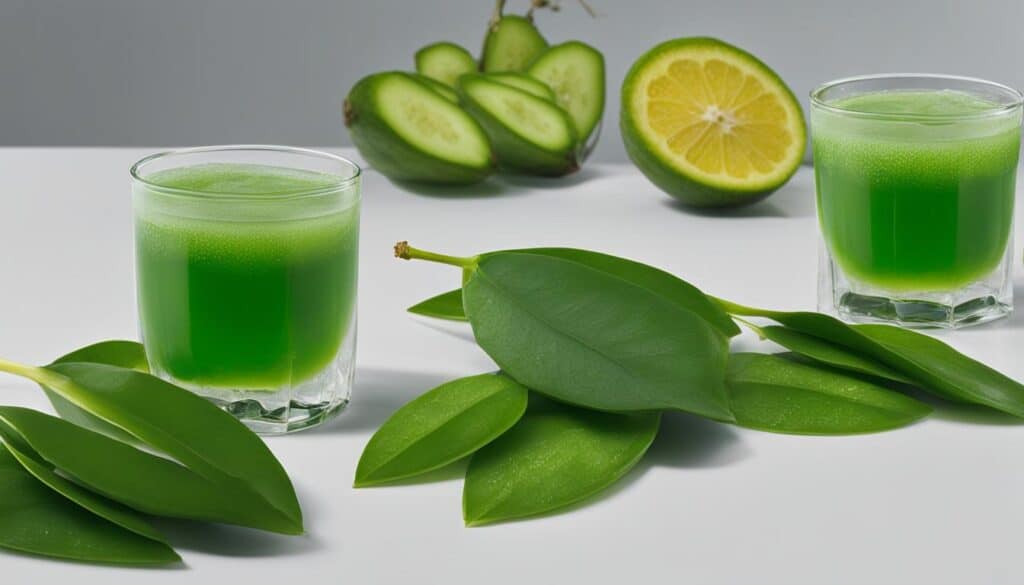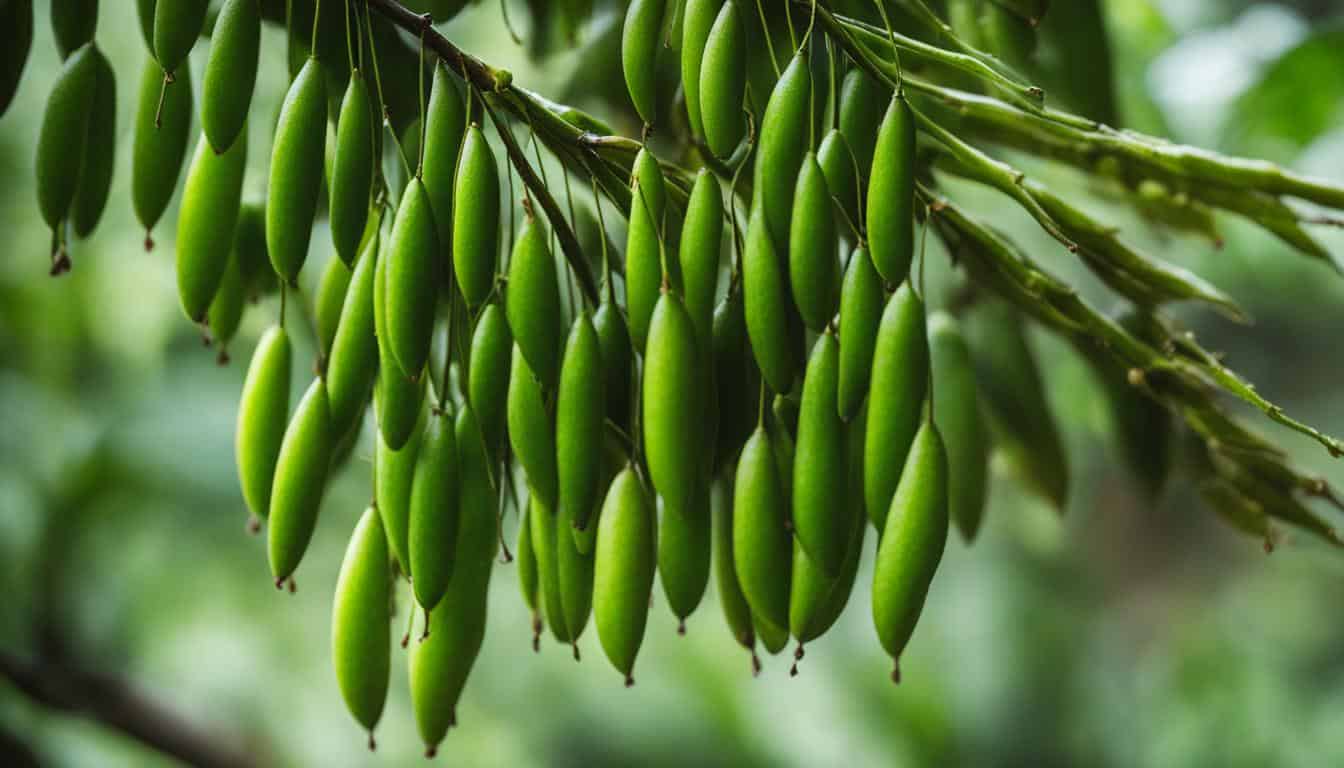Hey there, fruit enthusiasts! Today, I want to introduce you to a hidden gem in the world of exotic fruits – the bilimbi. If you’re someone who loves exploring unique and lesser-known fruits, then bilimbi should definitely be on your must-try list. Trust me, you don’t want to miss out on this exciting culinary adventure!
Bilimbi is a fruit that’s been flying under the radar for far too long. Its distinctive flavor and potential health benefits make it a true hidden treasure waiting to be discovered. So buckle up and let’s dive into the wonderful world of bilimbi!
The Origins of Bilimbi
Bilimbi is a fruit tree that belongs to the Averrhoa bilimbi species. Unlike its relative, the starfruit, bilimbi bears fruit directly from its trunk, making it visually unique. The origins of bilimbi can be traced back to countries like Costa Rica and the Far East, where it has been used in various culinary applications.
In Costa Rica, the uncooked green fruits of the bilimbi tree are used to prepare a relish that pairs well with rice and beans, fish, and meat. In the Far East, ripe bilimbis are added to curries, giving them a tangy and refreshing flavor. This versatile fruit can also serve as a substitute for mango in chutney recipes, be pickled, boiled with sugar to make jam or acid jelly, or preserved in brine. With so many culinary possibilities, bilimbi is a fruit that offers a world of exploration.
The Origins of Bilimbi
Bilimbi, scientifically known as Averrhoa bilimbi, is a fruit tree that boasts a distinctive growth pattern. Unlike its relative, the starfruit, which bears fruit on its branches, bilimbi fruit grows directly from the trunk. This unique characteristic sets it apart and adds to its visual appeal.
Indigenous to countries like Costa Rica and the Far East, bilimbi has a rich culinary history. In Costa Rica, the unripe green fruits are often used to prepare a relish that complements rice and beans, fish, and meat dishes. In the Far East, ripe bilimbi fruits are incorporated into curries, lending their tangy and refreshing flavor. Additionally, bilimbi can be transformed and used in various other culinary applications, such as chutney, pickling, jam-making, and preservation in brine.
The origins of bilimbi and its diverse culinary uses make it an intriguing fruit worth exploring for any adventurous food lover.
Culinary Uses of Bilimbi
Bilimbi, with its unique flavor and tangy taste, is a versatile fruit that can be used in various culinary applications. While it is generally considered too acidic to be eaten raw, there are several creative ways to incorporate bilimbi into your dishes.
Making Bilimbi Relish
A popular use for bilimbi is in making relish. In Costa Rica, the unripe green fruits are used to prepare a relish that pairs perfectly with rice and beans, fish, and meat. The tartness of the bilimbi adds a refreshing and tangy flavor to the relish, making it a delightful accompaniment to savory dishes.
Adding to Curries and Chutney
Ripe bilimbi fruits are often used in curries in the Far East, where they add a tangy and slightly sour note to the dish. The unique flavor of bilimbi can also be harnessed in making chutney, where it can be used as a substitute for mango. The tartness of the bilimbi pairs well with the sweetness of other ingredients, creating a well-balanced and flavorful condiment.
Pickling and Making Jam
Bilimbi can also be preserved through pickling. The fruit’s natural acidity makes it an ideal candidate for pickling, as the tartness is preserved even after the pickling process. Additionally, bilimbi can be boiled with sugar to make jam or acid jelly. The resulting jam has a unique tangy taste that pairs well with bread or can be used as a topping for desserts.
Bilimbi’s versatility in the kitchen opens up a world of possibilities for culinary exploration. Whether you’re adding it to curries, making chutney, pickling it, or turning it into jam, bilimbi is sure to bring a tangy twist to your dishes.
Bilimbi Juice and Beverages

When it comes to enjoying the tangy and refreshing flavor of bilimbi, one of the most popular ways is through its juice. Bilimbi juice is a favorite in various regions and is often used to make cooling beverages that are similar to lemonade. The acidity of the juice adds a delightful zing, making it a perfect choice for those hot summer days.
To create bilimbi juice, the fruit is typically blended and strained to remove any seeds or pulp. The resulting juice can be enjoyed on its own, or for an extra burst of flavor, it can be mixed with other fruits or flavors. Imagine combining bilimbi juice with pineapple or mango for a tropical-inspired beverage that will transport your taste buds to paradise.
If you’re feeling adventurous, you can even experiment with adding bilimbi juice to your favorite cocktails, mocktails, or even homemade popsicles. The possibilities are endless when it comes to creating refreshing drinks with bilimbi juice.
| Benefits of Bilimbi Juice | Ways to Enjoy Bilimbi Juice |
|---|---|
|
|
“Bilimbi juice is like a burst of sunshine in a glass. Its tangy flavor and vibrant color make it a delightful and refreshing beverage option.” – Food and Drink Expert
The Perfect Bilimbi Lemonade Recipe
If you’re looking for a simple yet delicious way to enjoy bilimbi juice, try making a refreshing bilimbi lemonade. Here’s a quick and easy recipe to get you started:
- In a pitcher, combine freshly squeezed lemon juice, bilimbi juice, and a sweetener of your choice, such as honey or agave syrup.
- Add cold water and stir well to ensure the sweetener is fully dissolved.
- Fill glasses with ice cubes and pour the bilimbi lemonade over the ice.
- Garnish with a slice of lemon or a sprig of mint.
- Enjoy your homemade bilimbi lemonade and savor the tangy and refreshing flavors!
Health Benefits of Bilimbi
Bilimbi is not just a tasty fruit, but it also offers potential health benefits. It is rich in antioxidants, which help protect the body against free radicals and oxidative stress. Antioxidants are compounds that neutralize harmful molecules in the body and prevent damage to cells and tissues. By incorporating bilimbi into your diet, you can potentially boost your overall well-being and support a healthy immune system.
Additionally, bilimbi has been used in traditional medicine for its potential medicinal properties. Its acidic nature makes it a natural remedy for certain skin conditions like acne and rashes. The high vitamin C content in bilimbi also contributes to its potential skin benefits, as vitamin C is known to promote collagen production and improve skin health.
Furthermore, bilimbi is believed to aid in digestion. Its tangy taste stimulates the production of digestive enzymes, which can help in the breakdown of food and improve nutrient absorption. Its natural acidity can also have a calming effect on the stomach and reduce symptoms of indigestion.
The Potential Health Benefits of Bilimbi
“Incorporating bilimbi into your diet can be a delicious way to potentially boost your overall well-being.”
While more research is needed to fully understand the extent of these health benefits, the unique properties of bilimbi make it an intriguing fruit to include in your daily routine. Whether you enjoy it in juices, jams, or as a flavorful addition to your favorite dishes, bilimbi can bring a tangy twist to your culinary adventures while potentially offering some extra health perks. So why not give this exotic fruit a try and experience the wonder of bilimbi for yourself?
Growing Your Own Bilimbi Tree

If you’re intrigued by bilimbi and want to experience its unique flavor firsthand, why not consider growing your own tree? Bilimbi trees, known scientifically as Averrhoa bilimbi, can be cultivated in tropical and subtropical regions. They are relatively low-maintenance and can thrive in a variety of soil types. With proper care and attention, you can have your very own source of bilimbi fruits right in your backyard.
When growing a bilimbi tree, it’s important to provide it with the right conditions. Ideally, the tree should be planted in a location that receives full sun or partial shade throughout the day. Well-draining soil is also essential to prevent waterlogging, which can lead to root rot. Water the tree regularly, especially during dry periods, but avoid overwatering as this can also be detrimental to its growth.
During the first few years of its life, a bilimbi tree may need some protection from strong winds and cold temperatures. Consider using windbreaks or covering the tree with a protective cloth or blanket during harsh weather conditions. Pruning is also important to maintain the tree’s shape and promote healthy growth. Remove any dead or diseased branches and trim back excessive growth to improve air circulation.
Tips for Growing Bilimbi Trees:
- Plant the tree in a sunny or partially shaded location with well-draining soil.
- Water the tree regularly, especially during dry periods, but avoid overwatering.
- Protect the tree from strong winds and cold temperatures during its early years.
- Prune the tree to remove dead or diseased branches and promote healthy growth.
Growing your own bilimbi tree can be a rewarding experience that allows you to enjoy the unique taste and versatility of this exotic fruit right from your own backyard. Whether you choose to use it in culinary creations or simply enjoy the fruit fresh from the tree, the vibrant flavors of bilimbi are sure to captivate your taste buds. So why not embark on this horticultural adventure and start growing your own bilimbi tree today?
Exploring Bilimbi at Fruit and Spice Park

If you’re not able to grow your own bilimbi tree, don’t worry! There are places where you can explore and taste this exotic fruit. Fruit and Spice Park in Homestead, FL is one such destination. The park offers a wide variety of tropical fruits, including bilimbi, that you can taste and discover. It’s a great opportunity to expand your palate and experience the flavors of bilimbi in a beautiful setting.
Fruit and Spice Park is a paradise for fruit enthusiasts and a hidden gem in Florida. Spanning over 37 acres, the park is home to more than 500 varieties of exotic fruits, including the elusive bilimbi. As you wander through the lush landscape, you’ll have the chance to see and taste fruits that you may have never encountered before. From rare tropical treasures to familiar favorites, the park offers a truly immersive experience in the world of exotic fruits.
During your visit to Fruit and Spice Park, you can participate in guided tours that provide fascinating insights into the history, cultivation, and culinary uses of the fruits. The knowledgeable guides will introduce you to the unique flavors and aromas of bilimbi, helping you appreciate its distinct characteristics. You’ll learn about the cultural significance of this fruit and discover how it has been incorporated into dishes from around the world.
One of the highlights of visiting Fruit and Spice Park is the opportunity to taste bilimbi firsthand. Whether you prefer to savor it on its own or try it as part of a fruit platter, the park offers a memorable experience for fruit enthusiasts of all ages. And if you find yourself falling in love with bilimbi, you can even purchase fresh fruits or plants to take home and continue your bilimbi journey.
Unforgettable Experiences with Bilimbi
When it comes to exotic fruit tasting, bilimbi is a standout choice that promises an unforgettable experience. The flavor of bilimbi can be best described as sour and “green”, reminiscent of a green starfruit. While this unique tanginess may not appeal to everyone, it is precisely what makes bilimbi so intriguing and memorable.
One of the most remarkable aspects of bilimbi is its versatility in culinary applications. From the traditional use of unripe bilimbis in relishes served with rice and beans, fish, and meat in Costa Rica, to the addition of ripe bilimbis in curries in the Far East, this fruit offers a range of possibilities. It can even be pickled, boiled with sugar to make jam or acid jelly, or preserved in brine. The vibrant flavors of bilimbi add a tangy twist to any dish, and its inclusion in your culinary repertoire is sure to be a conversation starter.
When it comes to fruit rankings, bilimbi is often seen as a top contender among exotic fruits. Its unique flavor profile sets it apart from more common fruits, making it a sought-after delicacy for adventurous eaters. Whether you’re a seasoned fruit enthusiast or someone looking to expand their palate, exploring bilimbi is an exciting journey into the world of exotic flavors.
So, why not embark on your own culinary adventure with bilimbi? Sample its tangy flavor, experiment with its versatile uses, and discover why this fruit is beloved by those who have had the pleasure of experiencing it. With its unforgettable taste and a place high on the list of exotic fruits, bilimbi may just become one of your personal favorites.
The Enchanting World of Exotic Fruits

Exploring the world of exotic fruits is like stepping into a vibrant tropical paradise. These fruits, with their intriguing shapes, vibrant colors, and intoxicating aromas, offer a sensory experience like no other. From the tangy sweetness of a dragon fruit to the creamy indulgence of a rambutan, each fruit has its own unique flavor profile that adds a touch of excitement to your palate.
One of the joys of exploring exotic fruits is the opportunity to discover new tropical flavors. Whether you’re savoring the juicy burst of a lychee, the tartness of a passion fruit, or the tropical notes of a durian, each bite transports you to a faraway land. The flavors are often bold and unexpected, awakening your taste buds and providing a refreshing escape from the everyday.
Embarking on a fruit exploration journey allows you to appreciate the incredible diversity of nature’s bounty. From the prickly exterior of a jackfruit to the velvety texture of a mangosteen, each fruit is a marvel of nature’s design. The experience of encountering these fruits, whether at a local market or during a tropical getaway, is an enchanting reminder of the beauty and abundance of the natural world.
The Delights of Exotic Fruit Tasting
Exotic fruit tasting is a delightful adventure that unveils a whole new world of flavors and textures. It’s an opportunity to broaden your culinary horizons and introduce your taste buds to something truly extraordinary. Whether you’re sampling tropical fruits at a local farmers market or having a fruit-centric meal at a tropical resort, the experience of trying these fruits is both educational and delicious.
“Exotic fruits are a feast for the senses – their vibrant colors, intoxicating aromas, and unique flavors make every bite a delightful adventure.”
As you delve into the world of exotic fruits, you’ll find yourself discovering new favorites and expanding your palate. Whether it’s the custard-like flesh of a cherimoya, the tartness of a carambola, or the creamy richness of a soursop, each fruit offers a new taste sensation. You can’t help but marvel at the incredible variety and complexity of flavors that nature has to offer.
So, embrace your sense of adventure and embark on a fruit exploration journey. Dive into the enchanting world of exotic fruits and let their tropical flavors transport you to paradise.
Conclusion
In conclusion, the bilimbi fruit is a hidden gem that should not be overlooked. With its tangy flavor and versatility in the kitchen, it offers a unique culinary adventure for those willing to try something new. Whether you choose to grow your own bilimbi tree or visit a fruit park to explore this exotic fruit, be prepared for a delightful journey of taste and discovery.
The bilimbi fruit not only tantalizes the taste buds but also has potential health benefits. Packed with antioxidants, it can contribute to your overall well-being. Additionally, its traditional medicinal uses make it even more intriguing.
So, why not embark on a culinary adventure and give the bilimbi fruit a try? Whether you’re an adventurous foodie or simply curious about exotic flavors, the bilimbi fruit is sure to captivate your senses and leave a lasting impression. Discover the wonders of bilimbi and elevate your culinary experiences to new heights!
FAQ
Can I eat bilimbi raw?
Bilimbi is generally considered too acidic to be eaten raw. It is commonly used in culinary applications such as relish, curries, chutney, and pickling.
Where can I try bilimbi juice?
Bilimbi juice is popular in various regions and can be enjoyed on its own or mixed with other fruits or flavors. You can try bilimbi juice at Fruit and Spice Park in Homestead, FL.
What health benefits does bilimbi have?
Bilimbi is rich in antioxidants, which help protect the body against free radicals and oxidative stress. It has also been used in traditional medicine for treating skin conditions, supporting digestion, and reducing inflammation.
How can I grow my own bilimbi tree?
Bilimbi trees can be cultivated in tropical and subtropical regions. They are relatively low-maintenance and can thrive in a variety of soil types. With proper care and attention, you can grow your own bilimbi tree in your backyard.
Where can I explore and taste bilimbi?
Fruit and Spice Park in Homestead, FL is a great destination to explore and taste various exotic fruits, including bilimbi. It’s a chance to expand your palate and experience the flavors of bilimbi in a beautiful setting.
How would you describe the flavor of bilimbi?
Bilimbi has a unique and distinctive flavor that can be described as sour and “green,” similar to a green starfruit. Some find its acidity off-putting, while others appreciate its tangy and refreshing taste.
What other exotic fruits are worth trying?
The world of exotic fruits is filled with unique flavors. Some other fruits worth trying include dragon fruit, jackfruit, durian, and rambutan.
Is bilimbi a popular fruit?
Bilimbi is relatively unknown and deserves more attention. It is often overlooked compared to more familiar fruits, but once tasted, it can become a personal favorite.
Can I use bilimbi in cooking?
Yes, bilimbi can be used in various culinary applications. It can be added to relish, curries, chutney, pickling, and even used to make jam or jelly.
Are there other parks or places to explore exotic fruits?
Yes, there are many fruit parks and gardens around the world where you can explore and taste a variety of exotic fruits. Some notable places include the Fruit and Spice Park in Florida, Dole Plantation in Hawaii, and the Fairchild Tropical Botanic Garden in Miami.





Leave a Reply